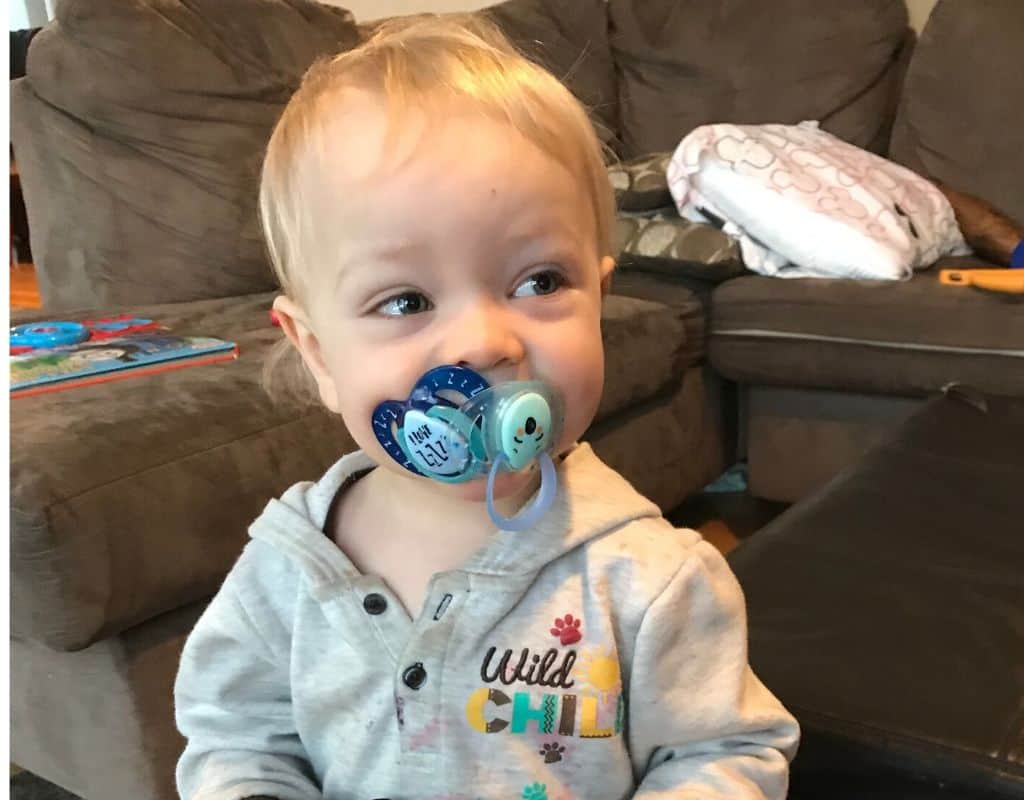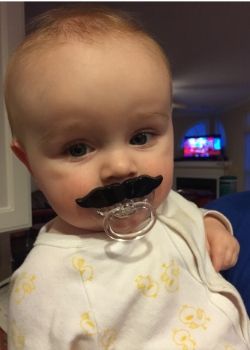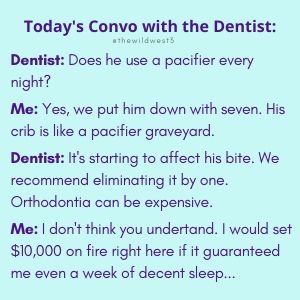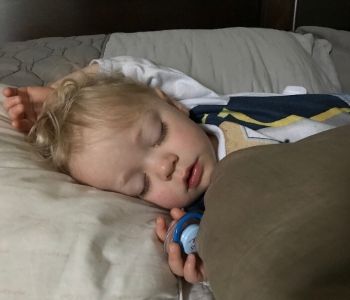
How to get rid of the pacifier is a question that has plagued me three times already (and I have a fourth baby on the way). If you came here searching for a how-to strategy and some practical tips for getting rid of the pacifier, you’re in the right place!
Important: Be sure to pick the right strategy for YOUR child.
Every parent knows: every kid is different. Your child’s age, maturity, and personality will all factor into your decision about when to get rid of the pacifier and how to take it away.
The strategies that work for weaning a four-year-old off a pacifier are not necessarily the same ones you would use to get an infant or toddler to sleep without a pacifier.
I’ll share a bunch of ideas for getting rid of the pacifier and, as with most things in parenting, you can pick and choose what works best for your child and your family.

Step One: Curse the day you ever introduced that freaking pacifier.
Just kidding! During those infant days, when you were wandering through a sleep-deprived hellscape, anything that provided some peace and quiet, and God-willing, SLEEP, was the right move at the time.
Yes, you might have some moments of regret over the next few days as you attempt to get rid of your child’s beloved pacifier, but just remember how much it helped you when the struggle was so real!
Okay, the REAL first step: take away the pacifier during the day– especially during awake time
No matter how old your child is, I think it’s easiest to start with getting rid of the pacifier during the day. Getting rid of the pacifier at night is, in my opinion, a much more difficult task.
If your child is used to using the pacifier during the day, and you’re ready to get rid of it, I suggest just taking away the pacifier cold turkey. You can be honest (you’re a big boy/girl now and we don’t use the pacifier) or you can lie (Mommy can’t find it right now…).
In either case, I find distraction and redirection works well when the child asks for their pacifier.
For my oldest two children, this is what we did. We cut out the pacifier during the day (and we took it away cold turkey) before we attempted to deal with the night.
For our third child, we had “wisened up,” if you will, and we just never really gave it to him during awake time in the first place. He’s always just used it to sleep.
Honestly, you might be in for a fussy day or two, but most kids adapt to losing the pacifier during the day rather quickly. It’s getting rid of the pacifier at night that can be a bit of an… ahem… adventure.

If your kid is particularly chill, or you just want to go ahead and get it over with, you could certainly take away the pacifier at night and during the day, all at once (you over-achiever, you!)
How to get rid of the pacifier at night
I said “at night” but really, I mean “during sleep.” Technically, you could let your child keep the pacifier during naptime and then take the pacifier away at night (or vice versa), but this seems like a really confusing approach and a good way to drag out your misery.
To your child, nap time and night-time sleep are pretty much the same, so it’s wise for you to treat them that way as well.
First, you have to decide when to get rid of the pacifier
Identifying when you should get rid of the pacifier is the most obvious first step. While I would argue that there’s really never a bad time to take away the pacifier during the day, getting rid of the pacifier at night is a different story.
Don’t try to tackle too much at once
Taking away the pacifier doesn’t have to be a long, drawn-out nightmare. Still, it is a big transition for your child.
Try to avoid tackling multiple transitions at once. In other words, potty-training, moving to a big-kid bed or new bedroom, introducing a new sibling, etc. — these are all things that should (ideally) take place separately from taking away the pacifier.
With our third child, we had to delay a lot of our planned transitions because I was so dreadfully ill with “morning” sickness for so long. As a result, we really had to thread the needle with cramming in all these transitions before the arrival of our fourth without allowing the transitions to overlap one another.
Once you know the time is right for your child, think about the next question: Is it a good time for you? (see below)
Identify a good time for you to get crappy sleep
Obviously there’s never a great time to be sleep deprived (but you can click here to check out some hilarious sleep deprivation stories parents have shared with me), but there are some times that are definitely worse than others.
If you’re pregnant and suffering from morning or all-day sickness: Probably not a great time to take away the pacifier at night.
If your spouse is out of town for work, and you’re handling nights solo: Why should you get to have all the “fun”? Wait until your spouse returns home, then get rid of the pacifier.
Next: Identify HOW you plan to get rid of the pacifier.
This is really the most important part of the conversation when it comes to getting rid of the pacifier.
Are you taking it away cold turkey? Then go for it!
Are you taking a more gradual approach? Decide what that will look like.
Do you need to do anything to prepare your child? That depends. Is your child really old enough to understand an explanation?
If so, some parents find success by creating a “pacifier buddy.” They go to Build-A-Bear and, when you insert the stuffing and heart, they also insert the child’s pacifiers. The child watches the bear being assembled and understands that the pacifier is unavailable to them, but still inside the stuffed animal.
Other parents of older children have taken a tooth fairy approach to getting rid of the pacifier. They put the pacifier in a special place and the Pacifier Fairy takes it away, leaving a treat, money, or some other type of reward in its place.
I think these are both great approaches, if your kid is old enough. With that said, ideally (for their oral health), you will take the pacifier away before your child is old enough to understand these methods (but if you waited, no judgment here!).

Finally: Take the Pacifier Away (+ the method that worked best for us)
Once you’ve decided that you are ready to take away the pacifier, the timing is right, and you know how you wish to proceed, there’s only one thing left to do: Take it!
How We Did It (Three Times And Counting)
We made a small snip in the tip of the pacifier. This alters the way the pacifier feels in the mouth and the sucking is not as rewarding/soothing for the child.
(Use this method at your own risk — see explanation/disclaimer in the following section)
This doesn’t go unnoticed. Each time, our kids told us their pacifiers were broken.
We responded with, “Well, that’s your pacifier. I’m sorry…” then gave it back to them and put them to sleep. They would fuss some, and the sleep was a little more interrupted, but overall, it wasn’t as bad as we were expecting.
Then the next night, we would cut it a little more. Then a little more. Finally, by the end, there was nothing but a little nub they couldn’t even suck on.
For our older two kids, by the third or fourth night with a defective pacifier, they were ready to give up the pacifier altogether. They weren’t having any of the snipped-tip nonsense.
Our third child was a full year older (oops) and much more stubborn and set in his ways. He still has a pacifier with no tip attached that he insists on sleeping with, but I consider it a 95% victory.
When I put him down each night, he holds it (kind of like a security blanket) until he falls asleep. This is not jeopardizing his bite (you’re welcome dentist) and he doesn’t look or ask for it at any other time.

At some point, when I have the will, I’ll just disappear it from his crib altogether. (I’m 32-weeks-pregnant and I don’t care to deal with that right now). After a night or two, he’ll accept that the pacifier just isn’t coming back.
A word of caution if you decide to cut the pacifier
Keep a close eye on the tip of the pacifier if you go this route. Once the tip has been damaged, the pacifier can fray/splinter and pieces could be chewed off (and possibly present a choking hazard).
If you have a child that is a chewer/grinder, this method is definitely not going to be a good fit.
For this reason, once you start cutting the pacifier tips, it’s important to completely cut down the pacifier and wean them off of it as soon as possible.
You don’t want your child sleeping with a snipped pacifier for very long (unless, like my youngest, the tip is snipped low enough that it can’t fray and can no longer be used as an actual pacifier).
What to do if you decide against cutting the pacifier
If you decide that cutting the pacifier isn’t for you, that’s totally understandable. At that point, I would suggest taking away the pacifier cold turkey.
You can soothe your child by talking to them, rubbing their back, going into check on them periodically, but whatever you do, don’t give them back their pacifier.
Giving back the pacifier to a crying child is actually worse than never taking it at all. You’ll be setting yourself up for a loooooong drawn-out process.
Once you give it back, your child won’t understand why. If anything, they might associate their crying and carrying as the trick that initiated the pacifier’s return. At that point, the next time you try taking away the pacifier, they will just carry on for even longer, expecting the same result. Misery!
A word of caution: if you decide to take away the pacifier cold turkey, do what you need to do to get through those first few fussy nights within reason. For us, checking on them if they fussed for too long, laying them back down in their cribs, patting their backs, etc. all were helpful in bridging the gap for the first few nights without the pacifier (or in our case, the first few nights after cutting the pacifier).
Getting a baby or toddler to sleep without their pacifier isn’t fun at first, but be careful not to set up new sleep associations you don’t want to maintain.
For example, don’t start letting your child into bed with you if you don’t want that to continue. Don’t drive your child around so they’ll fall asleep without their pacifier (unless you plan to continue driving them for the following months). Don’t rock them until they fall asleep, unless you plan to continue rocking them.
You get the idea.
If you start doing these new things, you’re just setting them up for a new habit or sleep association you’ll need to break.
A final word about getting rid of the pacifier
Getting rid of the pacifier isn’t fun for anyone, but I’ve found that, overall, it’s actually gone better than I’d anticipated. The worst part is working up the initial will to do it. Because you don’t actually know how it’s going to go until you take the pacifier away, the dread is real.
Once you get rid of the pacifier, and the first few nights of sleep deprivation pass, I think you’ll be pleasantly surprised that the misery is milder and passes sooner than you expected (provided you don’t back-pedal and give the pacifier back).

In any case, I wish you all the best as you undertake this! You can do it!

Oh my gosh, the Paci! It was the hardest thing to get rid of when my daughter was this age.
I have a serious love-hate relationship with pacifiers in this house, but I can promise you this: our fourth kids is due next month and we will 100% be restocking our pacifier supply when he arrives!
I won’t lie I found your suggestion hilarious. The idea of snipping the pacifier over time until it’s a pointless nub is ingenious! Your response to the suggestion that it’s broken had me chuckling. Great tip.
I’m glad I could give you a chuckle! And seriously, I can’t remember where I initially heard the idea of cutting the pacifier, but it was years ago when I was trying to figure out how to get rid of the pacifier with my first kid. At first, I was skeptical, but now that we’ve cut the pacifier for three kids in a row, I have to say — I’m a believer!
There’s some great tips in here! My son will be 3 in April and he still sleeps with it (but no daytime use!). I’m not strong enough to not give in if he cries through the night right now, so I’m hoping we can do something with an explanation of why it’s being taken away to where he understands he can’t have it back. I’m such a pushover since he’s my last baby, though.
Hi Michelle,
I totally know what you mean. When it comes to getting rid of the pacifier, you really have to pick the time that’s right for you and your family. This last one was the longest we waited, and it was a little harder for him to give up than the other kids, but he still gave up the fight pretty willingly.
Once we cut the pacifier, he was irritated, but he wasn’t super upset like I thought he might be. We were on a bit of a compressed timetable too because I wanted to make sure he’d been off the pacifier for a chunk of time before a new baby showed up on the scene, complete with a whole new batch of pacifiers!
Whenever you guys decide to take away the pacifier, I’m sure it will be the “right” time.
Charissa
This is so helpful. My daughter is 1 year old and she just has to have it to fall asleep.
I’m so glad you found these tips helpful! Getting rid of the pacifier at night is definitely the hardest part, in my opinion, but I also found that the younger we took it, the quicker my kids adapted. With each kid, we took away the pacifier a little later (because we were more exhausted and overwhelmed each time lol) and they took it a little harder. Still, even waiting until almost three with my most recent son, it wasn’t as bad as I was fearing.
I wish you good luck when the time comes!
Charissa